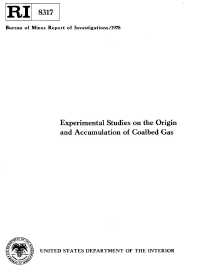Mining Publication: Experimental Studies on the Origin and Accumulation of Coalbed Gas
Original creation date: January 1978
The Bureau of Mines investigated factors that influence the formation of methane and other hydrocarbon gases in coal, which is an integral part of the coalification process. Coalification begins with a biogenetic stage in which plant debris decomposes and peat is formed; methane and CO2 are the predominant gases produced during this stage. During the diagenetic stage of coalification hydrogen and the hydrocarbon gases methane, ethane, ethylene, propane, propylene, butene, iso- and normal butane, and pentane are formed by dissociation of the organic material. Methane may also be produced by a secondary reaction of hydrogen with unsaturates or by the reduction of CO2. The gas contained in coalbeds is a mixture of methane, C2 through C5 alkanes, CO2, O2, N2, H2, and He; its heating value is equivalent to that of natural gas. The gas content of coal depends on many variables, but an empirical relationship between adsorptive capacity, rank, and depth has been observed.
Authors: AG Kim
Report of Investigations - January 1978
NIOSHTIC2 Number: 10000614
Pittsburgh, PA: U.S. Department of the Interior, Bureau of Mines, RI 8317, 1978 Jan; :1-18
See Also
- Degasification System Selection for U.S. Longwall Mines Using an Expert Classification System
- Development and Application of Reservoir Models and Artificial Neural Networks for Optimizing Ventilation Air Requirements in Development Mining of Coal Seams
- Forecasting Methane Hazards in Metal and Nonmetal Mines
- Geological Factors Affecting Methane in the Beckley Coalbed
- Geology and Methane Content of the Upper Freeport Coalbed in Fayette County, Pa.
- History of the Mining Program
- Hydraulic Stimulation of a Surface Borehole for Gob Degasification
- Modeling and Prediction of Ventilation Methane Emissions of U.S. Longwall Mines Using Supervised Artificial Neural Networks
- Remote Methane Sensors
- Removing Methane (Degasification) from the Pittsburgh Coalbed in Northern West Virginia
- Content source: National Institute for Occupational Safety and Health, Mining Program


 ShareCompartir
ShareCompartir
